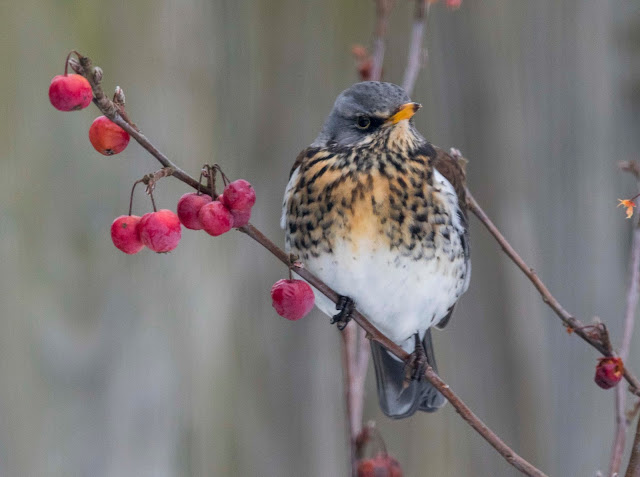Showing posts with label Thrushes. Show all posts
Showing posts with label Thrushes. Show all posts
Thursday, 1 March 2018
Fieldfare in the garden
We were so pleased to see a Fieldfare in the snow in the garden today (probably the same one more briefly yesterday afternoon). I hoped that it was attracted by the newly planted Crab Apple, and sure enough it spent some time feeding on the crabs on the tree itself. Paula took a photo with the iphone, and I followed up with a few of my own. Fieldfares are very dramatic thrushes, and I was also very pleased to see over a score scattered across the College grounds, but particularly on the banks of the ditch along the main drive. Make the most of it while its there I thought!
All plumped up...
The Fieldfare, Turdus pilaris, is a common winter visitor to the UK, one which I always absolutely delighted to see, and of course to hear. Perhaps a couple of pairs breed in the UK.
They do have a bit of a reputation of being driven into gardens in hard weather, feasting off crab or domestic apples and whatever they can find. Today was no exception, Twitter containing many similar experiences to our own. I must get some apples to put out! Meanwhile this particular bird has found my crab apple fruits.
I have come across one (only one) website that suggests that the female is a little duller. The juveniles are duller, without the grey head, but I assume they will have moulted before arrival in the UK I think.
About three quarters of a million migrate over to us each winter, starting in September but continuing until November at least.
25 cm long, wingspan about 40 cm, so quite a large thrush, nearly the size of a Mistle Thrush.
When a group is in a tree they all tend to face in the same direction, keeping up a constant chatter. When foraging on the ground, often in association with Redwings, the group works its way up wind, each bird pausing every so often to stand erect and gaze around before resuming feeding. When alarmed they fly off down wind and the feeding group reforms elsewhere.
When berries ripen in the autumn these are taken in great number. Hawthorn, holly, rowan, yew, juniper, dog rose, Cotoneaster, Pyracantha and Berberis are all relished. Later in the winter windfall apples are eaten, swedes attacked in the field and grain and seeds eaten
Subscribe to:
Comments (Atom)







